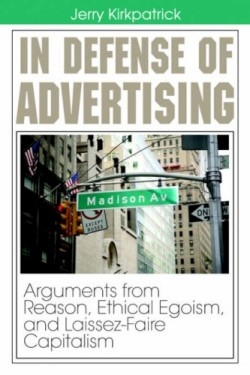In Defense of Advertising
Arguments from Reason, Ethical Egoism, and Laissez-Faire Capitalism
“Advertising and capitalism both are life-giving and benevolent institutions,” Kirkpatrick concludes at the end of In Defense of Advertising.
The analysis that results in this statement begins with a critique of those who criticize advertising and a list of disparaging comments launched toward the institution over the years. The author then states his overall goal—to describe two worldviews as they relate to his subject and then reveal the false premise of one, while presenting the reasons that the true ideology (objectivism) supports the existence and goodness of advertising—and, by extension, capitalism.
In Defense of Advertising is an updated softcover version of Dr. Kirkpatrick’s academic work first published in 1994. Using the ideas of Ayn Rand and Ludwig von Mises as his core premise, he takes on established thinkers like Arnold Toynbee and John Kenneth Galbraith—thereby limiting his discussions to documented treatises. The book is essentially a one-sided debate where the author describes the ideas of his opponents and then refutes the validity of their ideas.
Well-qualified to explore this topic, Kirkpatrick is a professor of international business and marketing at California State Polytechnic University in Pomona. His arguments are philosophical and occasionally amusing. Kirkpatrick explains that there are two methods to refute a theory: 1) demonstrate that if carried to a logical conclusion the results would be false or ridiculous and 2) attack an idea’s underlying premise. His lively rebuttal of the coercive power of advertising where the term “subliminal” melds into the concept of “déjà vu” and then into “sexual innuendo” is one example. He also hits the funny bone while debunking “intrinsicism.” The commandment, “Thou shalt not lie,” makes no provision for circumstances, he says. If a “…homicidal maniac comes to your door looking for your children,” he wonders, is it your moral duty is to answer him truthfully?
Scholarly and perhaps a bit pretentious, In Defense of Advertising uses television commercials that are decades old as examples. Even though Kirkpatrick acknowledges that in the preface and describes “Midge the Manicurist,” “Mr. Whipple,” and the “Take it ALL off Noxema lady,” this work would be more pertinent—especially since this is a revised edition—if it used examples familiar to today’s students. Given the censorial concerns about ads presented during the Super-Bowl, his professorial interpretation would have been interesting.
While easy to read, In Defense of Advertising is rich with information and supported by numerous references. It is many things: a rational discussion, a rambling dissertation about societal views and capitalism—and an intellectual exercise.
Disclosure: This article is not an endorsement, but a review. The publisher of this book provided free copies of the book to have their book reviewed by a professional reviewer. No fee was paid by the publisher for this review. Foreword Reviews only recommends books that we love. Foreword Magazine, Inc. is disclosing this in accordance with the Federal Trade Commission’s 16 CFR, Part 255.

